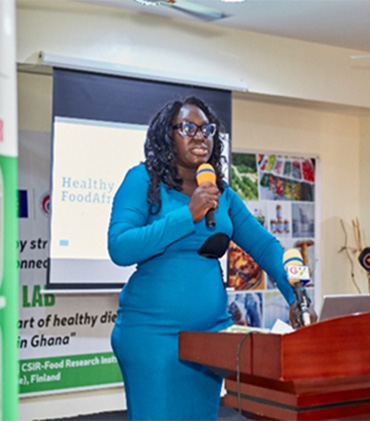
FOOD FORTIFICATION RESEARCH PORTFOLIO DEVELOPMENT AND MANAGEMENT
ProjectResearch Program
Fruits & Vegetables
Duration
1 Year 8 Months
Funding Source
EU
Collaborating Institutions
CSIR-Ghana
Project Acronym
2FAS-INSIDER
FOOD FORTIFICATION RESEARCH PORTFOLIO DEVELOPMENT AND MANAGEMENT (2FAS): INTEGRATED STRATEGIES FOR MICRONUTRIENT DEFICIENCY REDUCTION
The aim of the project is to evaluate how different strategies to combat micronutrient deficiencies (MNDs) can be combined, alongside diversification of diets, to maximize impact in West Africa, particularly amongst the most vulnerable populations, without increasing risks for overconsumption. The primary beneficiaries are the most vulnerable populations including young children and women of reproductive age in Ghana.
Introduction
Improving nutrition is of crucial importance to achieve the Sustainable Development Goals. Inadequate levels of micronutrients have severe and far-reaching adverse health consequences. These include impaired physical and cognitive development, poor neonatal and maternal outcomes, reduced work capacity of adults, and negative impacts on national economic development. The most vulnerable populations include young children and women of reproductive age. Despite substantial past and ongoing efforts, there remains a surprising lack of clarity about which interventions are most effective in addressing micronutrient deficiencies. This project therefore aims to evaluate how different strategies to combat micronutrient deficiencies (MNDs) can be combined, alongside diversification of diets, to maximize impact in West Africa, particularly amongst the most vulnerable populations, without increasing risks for overconsumption. The primary beneficiaries are the most vulnerable populations including young children and women of reproductive age in Ghana.
Key Activities and Achievements:
The INSIDER project is divided into 3 specific phases. The first phase concerns translating data into evidence, whereas the second phase concerns translating this evidence into policy. The third phase focuses on the dissemination of the results of the project. The 2FAS-INSIDER project in the period under review is in the final policy drafting phase.
The INSIDER Ghana study aimed at evaluating the impact associated implementation of national strategies and their primary outcomes and identify the main strategies employed to tackle malnutrition in the opinion of actors in the nutrition-related sectors of Ghana. The project’s aim extends to drawing on the consensus between stakeholders from all levels of decision making and implementation to develop policy recommendations and catalogue best practices. To do this the team undertook interviews with representatives of stakeholders between November 2020 and April, 2021. In all, eighteen key informants representing mainly independent academic/research professionals or health experts (n=5) and governmental organisations (n=4), local non-governmental organisations (n=3), food industry (n=4) and international non-governmental organisations (n=2) participated. Data was analysed collected and analysed Multicriteria Mapping analysis.
Participation was received from eighteen (18) of the twenty-six (26) invited respondents; giving a general response rate of 69.23%. This response rate was higher than that usually obtained for online/email-based surveys. Of the participants, nine (9) 52.94% were males and 8 (eight) females 47.06% and the participants were average aged 44.88±10.41 with
most being in the age category of above forty (40) years with a total of two hundred and fifty-two (252) years of experience between them. Out of the criterion participants expressed, twenty (20) 25% were categorised as resource issues and eighteen (18) 22.5% were categorized under political commitment, with fifteen (15) 18.75% falling under acceptability issues. The remaining criteria were either categorized under sustainability issues with fourteen (14) respondents making 18%, twelve (12) respondents under stakeholders’ commitment and impact issue having the least number of two (2).
Considering the complexity of issues such as acceptability, categorization decisions under each issue was based on multiple consideration for both the name and definition of the criterion from the stakeholder’s perspective. The criteria were grouped into the respective issues based on the definition of criteria provided by the participants through the interview and not necessarily just the name of the criteria. No participant evaluated the options by using more than 5 criteria.
To determine relative degree of importance of each criterion, stakeholders were asked to weight the criteria. Resources obtained the most weight across perspectives. Stakeholders’ commitment being the least selected issue for evaluation of the predefine option. The wide of lengths of graph bars indicate wide variance in the degree relative importance in evaluating of the options. The bands illustrate the highest and lowest weighting of participant’s criteria with the Issue, illustrating the degree of agreement (narrow band) on the relative importance of criteria within each Issue.
Project Team




More Projects
Let's Talk!
Want to Do Business With Us? Connect with us and let's set the ball rolling. Our experienced professionals are eager to help your business thrive.














